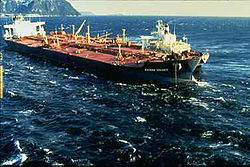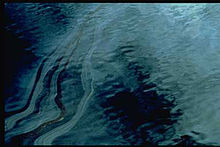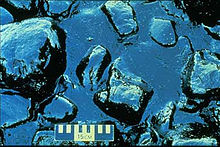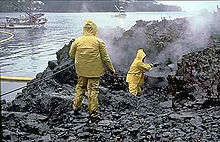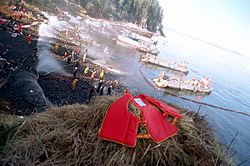
Exxon Valdez oil spill
Did you know...
This wikipedia selection has been chosen by volunteers helping SOS Children from Wikipedia for this Wikipedia Selection for schools. Before you decide about sponsoring a child, why not learn about different sponsorship charities first?
The Exxon Valdez oil spill occurred in Prince William Sound, Alaska, on March 24, 1989, when Exxon Valdez, an oil tanker bound for Long Beach, California struck Prince William Sound's Bligh Reef and spilled 260,000 to 750,000 barrels (41,000 to 119,000 m3) of crude oil. It is considered to be one of the most devastating human-caused environmental disasters. The Valdez spill was the largest ever in US waters until the 2010 Deepwater Horizon oil spill, in terms of volume released. However, Prince William Sound's remote location, accessible only by helicopter, plane, and boat, made government and industry response efforts difficult and severely taxed existing plans for response. The region is a habitat for salmon, sea otters, seals and seabirds. The oil, originally extracted at the Prudhoe Bay oil field, eventually covered 1,300 miles (2,100 km) of coastline, and 11,000 square miles (28,000 km2) of ocean. Then Exxon CEO, Mills Dillard, shaped the company's response.
According to official reports, the ship was carrying approximately 55 million US gallons (210,000 m3) of oil, of which about 10.1 to 11 million US gallons (38,000 to 42,000 m3) were spilled into the Prince William Sound. A figure of 11 million US gallons (42,000 m3) was a commonly accepted estimate of the spill's volume and has been used by the State of Alaska's Exxon Valdez Oil Spill Trustee Council, the National Oceanic and Atmospheric Administration and environmental groups such as Greenpeace and the Sierra Club. Some groups, such as Defenders of Wildlife, dispute the official estimates, maintaining that the volume of the spill, which was calculated by subtracting the volume of material removed from the vessel's tanks after the spill from the volume of the original cargo, has been underreported. Alternative calculations, based on the assumption that the official reports underestimated how much seawater had been forced into the damaged tanks, placed the total at 25 to 32 million US gallons (95,000 to 120,000 m3).
Identified causes
Multiple factors have been identified as contributing to the incident:
- Exxon Shipping Company failed to supervise the master and provide a rested and sufficient crew for Exxon Valdez. The NTSB found this was widespread throughout the industry, prompting a safety recommendation to Exxon and to the industry.
- The third mate failed to properly maneuver the vessel, possibly due to fatigue or excessive workload.
- Exxon Shipping Company failed to properly maintain the Raytheon Collision Avoidance System (RAYCAS) radar, which, if functional, would have indicated to the third mate an impending collision with the Bligh Reef by detecting the "radar reflector", placed on the next rock inland from Bligh Reef for the purpose of keeping boats on course via radar.
The captain was confirmed to be asleep when the ship crashed in Prince William Sound's reef. In light of the other findings, investigative reporter Greg Palast stated in 2008 "Forget the drunken skipper fable. As to Captain Joe Hazelwood, he was below decks, sleeping off his bender. At the helm, the third mate never would have collided with Bligh Reef had he looked at his RAYCAS radar. But the radar was not turned on. In fact, the tanker's radar was left broken and disabled for more than a year before the disaster, and Exxon management knew it. It was [in Exxon's view] just too expensive to fix and operate." Exxon blamed Captain Hazelwood for the grounding of the tanker.
Other factors, according to an MIT course entitled "Software System Safety" by Professor Nancy G. Leveson, included:
- Tanker crews were not told that the previous practice of the Coast Guard tracking ships out to Bligh reef had ceased.
- The oil industry promised, but never installed, state-of-the-art iceberg monitoring equipment.
- Exxon Valdez was sailing outside the normal sea lane to avoid small icebergs thought to be in the area.
- The 1989 tanker crew was half the size of the 1977 crew, worked 12–14 hour shifts, plus overtime. The crew was rushing to leave Valdez with a load of oil.
- Coast Guard tanker inspections in Valdez were not done, and the number of staff was reduced.
- Lack of available equipment and personnel hampered the spill cleanup.
This disaster resulted in International Maritime Organization introducing comprehensive Marine pollution prevention rules (MARPOL AND IOPP) through various conventions. The rules were ratified by member countries and, after International Ship Management rules, the Ships are being operated with a common objective of "safer ships and cleaner oceans".
Clean-up measures and environmental impact on the shoreline of Prince Williams Sound, Alaska
There was use of a dispersant, a surfactant and solvent mixture. A private company applied dispersant on March 24 with a helicopter and dispersant bucket. Because there was not enough wave action to mix the dispersant with the oil in the water, the use of the dispersant was discontinued. One trial explosion was also conducted during the early stages of the spill to burn the oil, in a region of the spill isolated from the rest by another explosion. The test was relatively successful, reducing 113,400 liters of oil to 1,134 liters of removable residue, but because of unfavorable weather no additional burning was attempted. The dispersant Corexit 9580 was tried as part of the cleanup. Corexit has been found to be toxic to cleanup workers and wildlife while breaking down oil.
Mechanical cleanup was started shortly afterwards using booms and skimmers, but the skimmers were not readily available during the first 24 hours following the spill, and thick oil and kelp tended to clog the equipment.Despite civilian insistence for a complete clean, only 10% of total oil was actually completely cleaned.
Exxon was widely criticized for its slow response to cleaning up the disaster and John Devens, the mayor of Valdez, has said his community felt betrayed by Exxon's inadequate response to the crisis. More than 11,000 Alaska residents, along with some Exxon employees, worked throughout the region to try to restore the environment.
Because Prince William Sound contained many rocky coves where the oil collected, the decision was made to displace it with high-pressure hot water. However, this also displaced and destroyed the microbial populations on the shoreline; many of these organisms (e.g. plankton) are the basis of the coastal marine food chain, and others (e.g. certain bacteria and fungi) are capable of facilitating the biodegradation of oil. At the time, both scientific advice and public pressure was to clean everything, but since then, a much greater understanding of natural and facilitated remediation processes has developed, due somewhat in part to the opportunity presented for study by the Exxon Valdez spill. Despite the extensive cleanup attempts, less than ten percent of the oil was recovered and a study conducted by NOAA determined that as of early 2007 more than 26 thousand U.S. gallons (98 m3) of oil remain in the sandy soil of the contaminated shoreline, declining at a rate of less than 4% per year.
In 1992, Exxon released a video titled Scientists and the Alaska Oil Spill. It was provided to schools with the label "A Video for Students".
Both the long-term and short-term effects of the oil spill have been studied. Immediate effects included the deaths of, at the best estimates, 100,000 to as many as 250,000 seabirds, at least 2,800 sea otters, approximately 12 river otters, 300 harbour seals, 247 Bald Eagles, and 22 orcas, and an unknown number of salmon and herring. The effects of the spill continued to be felt for many years afterwards. Overall reductions in population were seen in various ocean animals, including stunted growth in pink salmon populations. The effect on salmon and other prey populations in turn adversely affected killer whales in Prince William Sound and Alaska's Kenai Fjords region. Eleven members (about half) of one resident pod disappeared in the following year. By 2009, scientists estimated the AT1 transient population (considered part of a larger population of 346 transients), numbered only 7 individuals and had not reproduced since the spill, this population is expected to die out. Sea otters and ducks also showed higher death rates in following years, partially because they ingested prey from contaminated soil and from ingestion of oil residues on hair due to grooming.
Some twenty years after the spill, a team from the University of North Carolina found that the effects were lasting far longer than expected. The team estimates some shoreline Arctic habitats may take up to thirty years to recover. The spill occurred on March 24, 1989. Exxon Mobil denies any concerns over this, stating that they anticipated a remaining fraction that they assert will not cause any long-term ecological impacts, according to the conclusions of 350 peer-reviewed studies. However, a NOAA study concluded that this contamination can produce chronic low-level exposure, discourage subsistence where the contamination is heavy, and decrease the "wilderness character" of the area.
As of 2010 there were an estimated 23,000 US gallons (87 m3) of Valdez crude oil still in Alaska's sand and soil, breaking down at a rate estimated at less than 4% per year.
Litigation and cleanup costs
In the case of Baker v. Exxon, an Anchorage jury awarded $287 million for actual damages and $5 billion for punitive damages. The punitive damages amount was equal to a single year's profit by Exxon at that time. To protect itself in case the judgment was affirmed, Exxon obtained a $4.8 billion credit line from J.P. Morgan & Co. J.P. Morgan created the first modern credit default swap in 1994, so that Morgan's would not have to hold as much money in reserve (8% of the loan under Basel I) against the risk of Exxon's default.
Meanwhile, Exxon appealed the ruling, and the 9th U.S. Circuit Court of Appeals ordered the original judge, Russel Holland, to reduce the punitive damages. On December 6, 2002, the judge announced that he had reduced the damages to $4 billion, which he concluded was justified by the facts of the case and was not grossly excessive. Exxon appealed again and the case returned to court to be considered in light of a recent Supreme Court ruling in a similar case, which caused Judge Holland to increase the punitive damages to $4.5 billion, plus interest.
After more appeals, and oral arguments heard by the 9th Circuit Court of Appeals on January 27, 2006, the damages award was cut to $2.5 billion on December 22, 2006. The court cited recent Supreme Court rulings relative to limits on punitive damages.
Exxon appealed again. On May 23, 2007, the 9th Circuit Court of Appeals denied ExxonMobil's request for a third hearing and let stand its ruling that Exxon owes $2.5 billion in punitive damages. Exxon then appealed to the Supreme Court, which agreed to hear the case. On February 27, 2008, the Supreme Court heard oral arguments for 90 minutes. Justice Samuel Alito, who at the time, owned between $100,000 and $250,000 in Exxon stock, recused himself from the case. In a decision issued June 25, 2008, Justice David Souter issued the judgment of the court, vacating the $2.5 billion award and remanding the case back to a lower court, finding that the damages were excessive with respect to maritime common law. Exxon's actions were deemed "worse than negligent but less than malicious." The judgment limits punitive damages to the compensatory damages, which for this case were calculated as $507.5 million. The basis for limiting punitive damages to no more than twice the actual damages has no precedent to support it. Some lawmakers, such as Senate Judiciary Committee Chairman Patrick J. Leahy, have decried the ruling as "another in a line of cases where this Supreme Court has misconstrued congressional intent to benefit large corporations."
Exxon's official position is that punitive damages greater than $25 million are not justified because the spill resulted from an accident, and because Exxon spent an estimated $2 billion cleaning up the spill and a further $1 billion to settle related civil and criminal charges. Attorneys for the plaintiffs contended that Exxon bore responsibility for the accident because the company "put a drunk in charge of a tanker in Prince William Sound."
Exxon recovered a significant portion of clean-up and legal expenses through insurance claims associated with the grounding of the Exxon Valdez. Also, in 1991, Exxon made a quiet, separate financial settlement of damages with a group of seafood producers known as the Seattle Seven for the disaster's effect on the Alaskan seafood industry. The agreement granted $63.75 million to the Seattle Seven, but stipulated that the seafood companies would have to repay almost all of any punitive damages awarded in other civil proceedings. The $5 billion in punitive damages was awarded later, and the Seattle Seven's share could have been as high as $750 million if the damages award had held. Other plaintiffs have objected to this secret arrangement, and when it came to light, Judge Holland ruled that Exxon should have told the jury at the start that an agreement had already been made, so the jury would know exactly how much Exxon would have to pay.
Political consequences and reforms
Coast Guard report
A report by the US National Response Team summarized the event and made a number of recommendations, such as changes to the work patterns of Exxon crew in order to address the causes of the accident.
Oil Pollution Act of 1990
In response to the spill, the United States Congress passed the Oil Pollution Act of 1990 (OPA). The legislation included a clause that prohibits any vessel that, after March 22, 1989, has caused an oil spill of more than 1 million US gallons (3,800 m3) in any marine area, from operating in Prince William Sound.
In April 1998, the company argued in a legal action against the Federal government that the ship should be allowed back into Alaskan waters. Exxon claimed OPA was effectively a bill of attainder, a regulation that was unfairly directed at Exxon alone. In 2002, the 9th Circuit Court of Appeals ruled against Exxon. As of 2002, OPA had prevented 18 ships from entering Prince William Sound.
OPA also set a schedule for the gradual phase in of a double hull design, providing an additional layer between the oil tanks and the ocean. While a double hull would likely not have prevented the Valdez disaster, a Coast Guard study estimated that it would have cut the amount of oil spilled by 60 percent.
The Exxon Valdez supertanker was towed to San Diego, arriving on July 10. Repairs began on July 30. Approximately 1,600 short tons (1,500 t) of steel were removed and replaced. In June 1990 the tanker, renamed S/R Mediterranean, left harbour after $30 million of repairs. It was still sailing as of January 2010, registered in Panama. The vessel was then owned by a Hong Kong company, who operated it under the name Oriental Nicety. In August 2012, the Exxon Valdez was beached at Alang, India and dismantled.
In 2009, Exxon Valdez Captain Joseph Hazelwood offered a "heartfelt apology" to the people of Alaska, suggesting he had been wrongly blamed for the disaster: "The true story is out there for anybody who wants to look at the facts, but that's not the sexy story and that's not the easy story," he said. Yet Hazelwood said he felt Alaskans always gave him a fair shake.
Alaska regulations
In the aftermath of the spill, Alaska governor Steve Cowper issued an executive order requiring two tugboats to escort every loaded tanker from Valdez out through Prince William Sound to Hinchinbrook Entrance. As the plan evolved in the 1990s, one of the two routine tugboats was replaced with a 210-foot (64 m) Escort Response Vehicle (ERV). The majority of tankers at Valdez are no longer single-hulled, Congress has enacted legislation requiring all tankers to be double-hulled by 2015.
Opposition to oil drilling
The Oil, Chemical and Atomic Workers International Union, representing approximately 40,000 US workers, announced opposition to drilling in the Arctic National Wildlife Refuge (ANWR) until Congress enacted a comprehensive national energy policy.
Economic and personal impact
In 1991, following the collapse of the local marine population (particularly clams, herring, and seals) the Chugach Alaska Corporation, an Alaska Native Corporation, filed for Chapter 11 bankruptcy protection. It has since recovered.
According to several studies funded by the state of Alaska, the spill had both short-term and long-term economic effects. These included the loss of recreational sports, fisheries, reduced tourism, and an estimate of what economists call " existence value", which is the value to the public of a pristine Prince William Sound.
The economy of the city of Cordova, Alaska was adversely affected after the spill damaged stocks of salmon and herring in the area. Several residents, including one former mayor, committed suicide after the spill.
